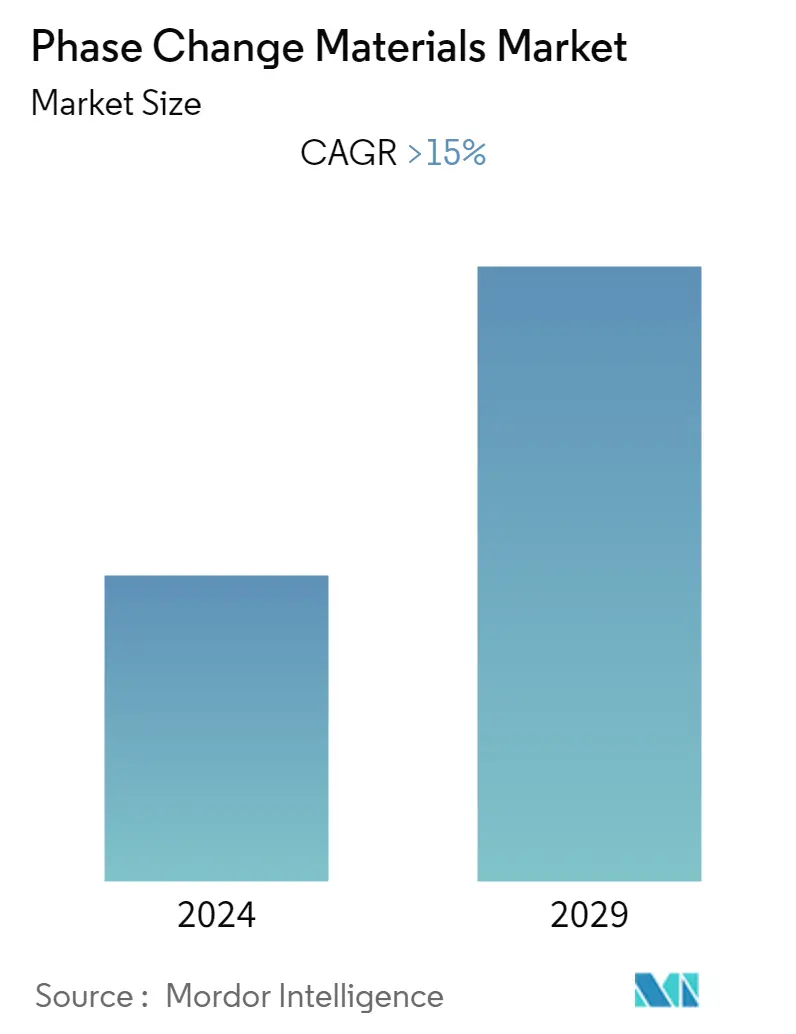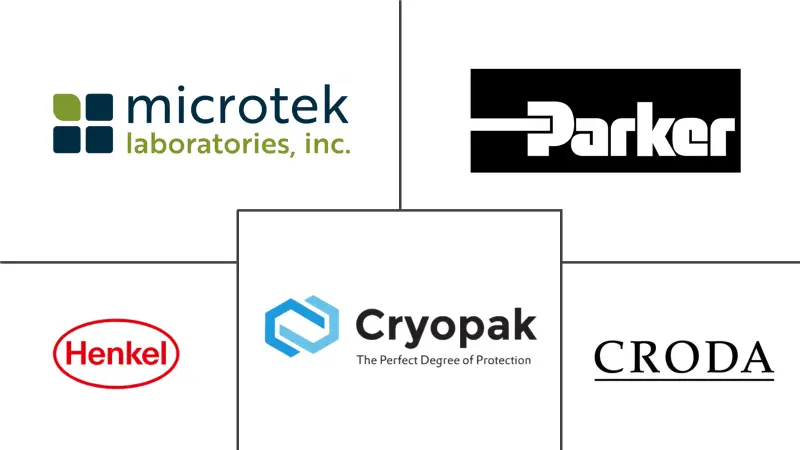Market Size of Phase Change Materials Industry

| Study Period | 2019 - 2029 |
| Base Year For Estimation | 2023 |
| CAGR | > 15.00 % |
| Fastest Growing Market | Asia Pacific |
| Largest Market | Europe |
| Market Concentration | Low |
Major Players
*Disclaimer: Major Players sorted in no particular order |
Phase Change Materials Market Analysis
The phase change materials market is expected to register a CAGR greater than 15% during the forecast period.
The phase change materials market was affected negatively due to the COVID-19 pandemic. The weakening transportation industry and a brief halt in construction activity due to the pandemic lockdown had a detrimental impact on the phase change materials market. However, the market reached pre-pandemic levels and is expected to grow steadily during the forecast period.
- The expanding global trend toward energy conservation and sustainable development is primarily driving the market. Because of the expanding construction sector, the organic product segment is also anticipated to propel the market ahead.
- However, the hazardous nature of phase change materials is expected to hinder the market's growth.
- The development of phase change thermal interface material and rising awareness of bio-based phase change materials is likely to act as an opportunity in the future.
- The continent of Europe long dominated the market. However, the Asia-Pacific region is anticipated to achieve the greatest CAGR throughout the projection period.
Phase Change Materials Industry Segmentation
A phase change material is a substance that releases/absorbs sufficient energy at phase transition to provide helpful heat/cooling. PCMs can provide district cooling and thermal buffer swings in buildings and store solar thermal energy for short-term or seasonal applications. The market is segmented by product type, encapsulation technology, end-user industry, and geography. By product type, the market is segmented into organic, inorganic, and bio-based products. Regarding encapsulation technology, the market is segmented into macro, micro, and molecular. End-user industry segmentation includes building and construction, packaging, textiles, electronics, transportation, and other end-user industries. The report also covers the market size and forecasts in 14 countries across major regions. The report offers market size and forecasts for phase change materials in terms of revenue (USD million) for all the above segments.
| By Product Type | |
| Organic | |
| Inorganic | |
| Bio-based |
| By Encapsulation Technology | |
| Macro | |
| Micro | |
| Molecular |
| By End-user Industry | |
| Building and Construction | |
| Packaging | |
| Textiles | |
| Electronics | |
| Transportation | |
| Other End-user Industries |
| Geography | |||||||
| |||||||
| |||||||
| |||||||
|
Phase Change Materials Market Size Summary
The phase change materials (PCM) market is poised for significant growth, driven by the increasing global focus on energy conservation and sustainable development. The market, which experienced a downturn due to the COVID-19 pandemic, has rebounded to pre-pandemic levels and is expected to expand steadily. The construction sector's growth, particularly in the Asia-Pacific region, is a key factor propelling the market forward. PCMs are increasingly utilized in building applications to enhance thermal efficiency, such as in under-floor heating systems and thermally efficient concrete. Despite the market's potential, the hazardous nature of some PCMs poses challenges, although advancements in bio-based and thermal interface materials present future opportunities.
The Asia-Pacific region is anticipated to experience the highest growth rate during the forecast period, fueled by rising demand from various end-user industries, including construction, packaging, textiles, electronics, and transportation. China's burgeoning packaging industry and India's rapidly expanding market are significant contributors to this growth. Additionally, the construction sectors in China and Japan are expected to drive demand for PCMs, supported by initiatives focusing on energy-efficient structures. The market remains fragmented, with key players like Cryopak, Microtek Laboratories Inc., and Henkel AG & Co. KGaA leading the charge. Recent innovations, such as Shanghai Polytechnic University's efficient phase change microcapsules and Sinomax USA's bio-based PCM technology, highlight the ongoing advancements in the industry.
Phase Change Materials Market Size - Table of Contents
-
1. MARKET DYNAMICS
-
1.1 Drivers
-
1.1.1 Expanding Global Trend Towards Energy Conservation and Sustainable Development
-
1.1.2 Other Drivers
-
-
1.2 Restraints
-
1.2.1 Hazardous Nature of Phase Change Materials
-
1.2.2 Other Restraints
-
-
1.3 Industry Value Chain Analysis
-
1.4 Porter's Five Forces Analysis
-
1.4.1 Bargaining Power of Suppliers
-
1.4.2 Bargaining Power of Consumers
-
1.4.3 Threat of New Entrants
-
1.4.4 Threat of Substitute Products and Services
-
1.4.5 Degree of Competition
-
-
1.5 Raw Material Analysis
-
1.6 Patent Analysis
-
-
2. MARKET SEGMENTATION (Market Size in Value)
-
2.1 By Product Type
-
2.1.1 Organic
-
2.1.2 Inorganic
-
2.1.3 Bio-based
-
-
2.2 By Encapsulation Technology
-
2.2.1 Macro
-
2.2.2 Micro
-
2.2.3 Molecular
-
-
2.3 By End-user Industry
-
2.3.1 Building and Construction
-
2.3.2 Packaging
-
2.3.3 Textiles
-
2.3.4 Electronics
-
2.3.5 Transportation
-
2.3.6 Other End-user Industries
-
-
2.4 Geography
-
2.4.1 Asia-Pacific
-
2.4.1.1 China
-
2.4.1.2 India
-
2.4.1.3 Japan
-
2.4.1.4 South Korea
-
2.4.1.5 Rest of Asia-Pacific
-
-
2.4.2 North America
-
2.4.2.1 United States
-
2.4.2.2 Canada
-
2.4.2.3 Mexico
-
-
2.4.3 Europe
-
2.4.3.1 Germany
-
2.4.3.2 United Kingdom
-
2.4.3.3 Italy
-
2.4.3.4 France
-
2.4.3.5 Rest of Europe
-
-
2.4.4 Rest of the World
-
2.4.4.1 Brazil
-
2.4.4.2 Saudi Arabia
-
2.4.4.3 South Africa
-
2.4.4.4 Other Countries
-
-
-
Phase Change Materials Market Size FAQs
What is the current Phase Change Materials Market size?
The Phase Change Materials Market is projected to register a CAGR of greater than 15% during the forecast period (2024-2029)
Who are the key players in Phase Change Materials Market?
Microtek Laboratories Inc., Henkel AG & Co. KGaA, Parker Hannifin Corp., Croda International Plc and Cryopak are the major companies operating in the Phase Change Materials Market.

